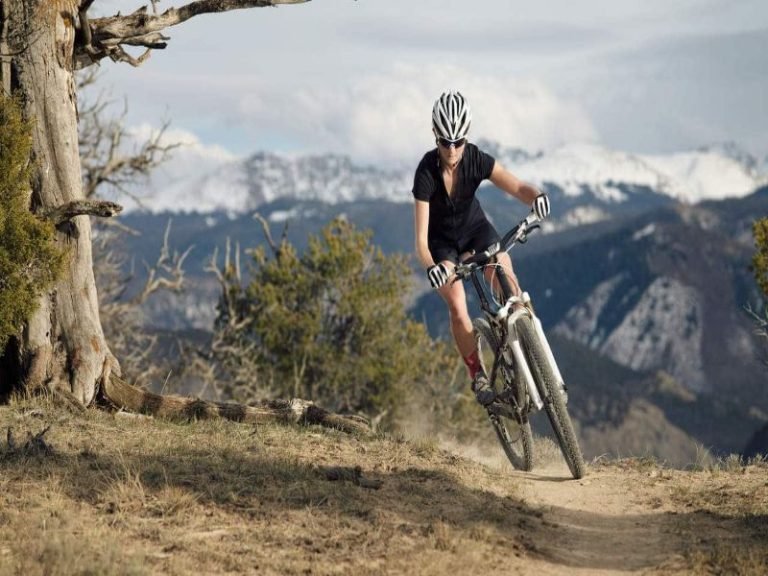Mountain Biking for Seniors
Age is no limit to the thrill of mountain biking! Explore our guide to mountain biking for seniors. Discover tips, gear suggestions, and ways to enjoy this adventurous hobby while staying active and safe.
Mountain biking for seniors is an invigorating outdoor recreational activity tailored to the unique needs and interests of older individuals. It involves navigating rugged terrains, forests, and challenging landscapes, all while relishing the natural beauty and adventure.
In this comprehensive guide, we’ll explore the numerous benefits of mountain biking for seniors, provide essential preparation tips, delve into trail selection, emphasize safety precautions, and discuss advanced biking techniques.
By the end of this guide, you’ll be well-equipped to embark on an exciting and fulfilling mountain biking journey in your later years.
Benefits of Mountain Biking for Seniors
Physical Health Benefits
Cardiovascular Fitness
Mountain biking offers an exceptional cardiovascular workout, enhancing heart health and circulation. Regular rides lower the risk of heart disease, reduce blood pressure, and boost overall endurance.
Muscle Strength and Endurance
Engaging in mountain biking activates various muscle groups, promoting strength and endurance. Expect improved leg, core, and upper body strength, which enhance mobility and balance.
Joint Flexibility and Mobility
Preserving joint flexibility and mobility is essential for an active senior lifestyle. Mountain biking’s controlled movements help maintain joint function and reduce stiffness.
Mental Health Benefits
Stress Reduction
The combination of spending time in nature, physical exertion, and the sense of freedom on the trail significantly reduces stress levels, providing a serene escape from daily worries.
Cognitive Stimulation
Mountain biking involves decision-making, navigation, and problem-solving, stimulating cognitive function and keeping the mind sharp.
Benefits of Biking for Mental Health
Mood Enhancement
Endorphins released during mountain biking contribute to improved mood and a sense of accomplishment, leading to heightened happiness and well-being.
Social Benefits
Building a Sense of Community
Participating in group rides or joining biking clubs fosters a sense of community and camaraderie among like-minded seniors, creating opportunities for lasting friendships.
Connecting with Like-Minded Individuals
Mountain biking offers a chance to connect with peers who share a passion for outdoor adventure and staying active, enriching your social life.
Opportunities for Group Activities
Group rides and events open doors to exciting experiences, from exploring new trails to organizing charity rides and adventure trips, and creating a vibrant social calendar.
Preparing for Mountain Biking
Health Check and Consultation
Consultation with a Healthcare Provider
Before embarking on your mountain biking journey, consult with a healthcare provider to ensure you’re physically fit.
Discuss any pre-existing medical conditions and receive guidance on adapting your biking routine.
Addressing Any Pre-existing Health Conditions
If you have conditions like heart disease, arthritis, or diabetes, your healthcare provider can offer tailored recommendations to manage them safely during mountain biking.
Choosing the Right Equipment
Selecting an Appropriate Bike
Choose a mountain bike designed for comfort and stability, with features like a step-through frame and wide, comfortable seats. Consider electric-assist bikes (e-bikes) for an extra boost of power when needed.
Safety Gear and Accessories
Invest in high-quality safety gear, including a well-fitting helmet, gloves, and padded shorts. Essential accessories include lights, reflective gear, and a hydration pack for a safe and enjoyable ride.
Skill Development
Basic Biking Skills
Start with the basics, such as mounting and dismounting your bike, shifting gears, and using brakes effectively. Practice these skills in a controlled environment before hitting the trails.
Trail-Specific Skills
As you progress, focus on trail-specific skills, such as navigating tight turns, riding over obstacles, and mastering body positioning for balance and control. Consider lessons or joining a biking group for guidance.
Finding Suitable Trails
Trail Difficulty Levels
Trails are categorized into different difficulty levels. Seniors should begin with easy trails to build confidence and gradually progress to intermediate and advanced trails as their skills and fitness improve.
Locating Trails Near Your Area
Online Resources and Apps
Discover nearby mountain biking trails using online resources and mobile apps like Trailforks and AllTrails. These platforms provide detailed information on trail difficulty, length, and user reviews.
Local Biking Communities
Join local biking communities or clubs to gain insights into the best nearby trails. These groups often organize group rides and events, making it easier to find like-minded biking companions.
Trail Etiquette and Rules
Respect for Nature and Other Users
Always follow trail etiquette by staying on designated paths, avoiding disturbing wildlife, and leaving no trace. Show respect to other trail users, including hikers and fellow bikers.
Safety Guidelines
Prioritize safety by wearing your gear at all times, signaling intentions to fellow riders, and knowing your limits. Safety should be a top priority on the trails.
Safety Precautions
Proper Warm-up and Stretching
Engage in a warm-up routine before each ride to prepare muscles and joints. Stretching exercises improve flexibility and reduce the risk of injury.
Riding Within Your Limits
Know your physical limits and ride at a comfortable pace. Pushing too hard can lead to fatigue and accidents, so listen to your body and take breaks when needed.
Riding with a Buddy or Group
Whenever possible, ride with a buddy or a group of fellow seniors. Companions provide support and safety, enhancing the overall biking experience.
Carrying Necessary Supplies
Water, Snacks, and First-Aid Kit
Stay hydrated with an adequate water supply. Pack energy-boosting snacks and a basic first-aid kit to address minor injuries or emergencies.
Navigation Tools (Maps or GPS)
Ensure you have reliable navigation tools, such as trail maps or a GPS device, to stay on course and prevent getting lost.
Emergency Procedures
Handling Injuries and Accidents
Learn basic first-aid procedures for common biking injuries like cuts, bruises, or minor sprains. Carry a fully stocked first-aid kit and know how to use it.
Communication Devices
Carry a charged cell phone or communication device for emergency calls. Share your biking plans with someone who can check in on you if needed.
Mountain Biking Techniques for Seniors
Climbing Hills
Master hill climbing techniques by shifting gears properly, maintaining a steady pace, and using body weight for balance. Practice on gradual inclines before tackling steep hills.
Descending Safely
Descend safely by controlling speed and maintaining a stable posture. Use brakes judiciously and shift your weight backward to prevent flipping over the handlebars.
Navigating Obstacles
Learn to navigate obstacles like rocks, roots, and fallen branches by lifting your front wheel and using your body weight for balance. Begin on beginner-friendly trails to build confidence.
Maintaining Balance and Stability
Balance is crucial to safe mountain biking. Practice by riding slowly in a straight line and gradually progressing to more challenging terrain.
Maintenance and Care
Bike Maintenance
Regular Check-ups
Schedule regular bike maintenance check-ups to ensure optimal condition. Regularly inspect brakes, tires, gears, and suspension to prevent breakdowns on the trail.
Cleaning and Lubrication
After each ride, clean your bike to remove dirt and debris. Lubricate the chain and other moving parts to maintain smooth operation.
Personal Health Maintenance
Rest and Recovery
Listen to your body and allow sufficient time for rest and recovery between rides. Adequate rest ensures you are ready for the next adventure.
Stretching and Flexibility Exercises
Incorporate stretching and flexibility exercises into your routine to improve joint mobility and reduce the risk of injuries. Stretch major muscle groups before and after each ride.
Joining Senior Mountain Biking Groups
Benefits of Group Riding
Participating in group rides offers numerous benefits, including increased motivation, improved safety, and a sense of camaraderie. Riding with others can make the experience more enjoyable.
Finding Local Senior Biking Clubs
Search for local senior biking clubs or organizations dedicated to promoting mountain biking among older adults. These clubs often organize group rides, workshops, and social events.
Participating in Group Events and Rides
Get involved in group events and rides organized by senior biking clubs. These activities provide opportunities to explore new trails, share experiences, and build lasting friendships.
Overcoming Challenges
Fear and Anxiety
It’s common to experience fear and anxiety, especially on challenging trails. Overcome these feelings with gradual exposure, supportive companions, and guidance from experienced riders.
Physical Limitations
Seniors may face physical limitations, but these can often be managed or adapted. Consult healthcare professionals for personalized advice and consider modifying your biking style or equipment as needed.
Persistence and Motivation
Maintaining a consistent biking routine can be challenging, but persistence pays off. Set achievable goals, track progress, and reward yourself for milestones reached.
Find motivation in the sense of accomplishment and improved well-being that mountain biking brings.
How to Get into Mountain Biking
To conclude, mountain biking for seniors offers a plethora of physical, mental, and social benefits. It enhances cardiovascular fitness, muscle strength, and joint flexibility while reducing stress and promoting cognitive stimulation.
Seniors can build a sense of community and connect with like-minded individuals through group activities. Whether you’re new to mountain biking or an experienced rider looking to adapt to changing needs, there’s no better time to embrace this exhilarating activity.
The rewards are immense, and the journey is as important as the destination. Start your adventure or continue your mountain biking journey with confidence. Mountain biking for seniors isn’t just a recreational activity; it’s a way of life that promotes health, happiness, and a deep connection with nature.
Embrace the trails, savor the moments, and relish the opportunity to lead an active and fulfilling life well into your senior years. The world of mountain biking awaits, and it’s never too late to start your journey.







